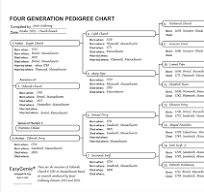Unlocking Your Family History: Exploring Ancestry Through a 4 Generation Pedigree Chart
The Importance of a 4 Generation Pedigree Chart in Genealogy Research
Genealogy research involves tracing one’s ancestry and understanding family connections across generations. A valuable tool in this process is the 4 generation pedigree chart, which provides a visual representation of a person’s direct ancestors over four generations.
By creating a 4 generation pedigree chart, genealogists can easily identify and organize vital information about their ancestors, such as names, birthdates, marriage dates, and locations. This chart helps genealogists track their lineage back through great-grandparents, great-great-grandparents, and beyond.
One of the key benefits of using a 4 generation pedigree chart is that it allows researchers to see patterns and connections within their family tree. By visually mapping out ancestral lines, genealogists can uncover missing links, identify common surnames or geographic locations, and spot potential areas for further research.
Moreover, the 4 generation pedigree chart serves as a roadmap for genealogical exploration. It helps researchers stay organized and focused on specific branches of their family tree while also providing a clear overview of their ancestry. This visual tool can be shared with other family members to foster discussions about shared heritage and familial connections.
In conclusion, the 4 generation pedigree chart is an essential tool for genealogists seeking to delve into their family history. By creating and utilizing this visual representation of ancestral lines, researchers can gain valuable insights into their heritage, track down elusive ancestors, and build a comprehensive picture of their family’s past.
Creating a 4-Generation Pedigree Chart: 5 Essential Tips for Accurate Family Mapping
- Start with yourself as the first generation on the pedigree chart.
- Include your parents in the second generation, grandparents in the third generation, and great-grandparents in the fourth generation.
- Use symbols to represent different genders and indicate relationships clearly.
- Record relevant information such as names, birth dates, death dates, and any known medical conditions or other important details.
- Consult with family members to gather accurate information for completing the pedigree chart.
Start with yourself as the first generation on the pedigree chart.
When creating a 4 generation pedigree chart, it is crucial to begin with yourself as the first generation on the chart. By placing yourself at the center of the chart and working backward through your direct ancestors, you establish a clear and logical framework for tracing your family history. Starting with yourself ensures that you accurately document your lineage and build a solid foundation for further genealogical research. This approach also helps maintain a personal connection to the information on the chart, making the process of exploring your ancestry more meaningful and engaging.
Include your parents in the second generation, grandparents in the third generation, and great-grandparents in the fourth generation.
When creating a 4 generation pedigree chart, it is essential to accurately place your ancestors in their respective generations. Begin by including your parents in the second generation, followed by your grandparents in the third generation, and finally, your great-grandparents in the fourth generation. This structured approach helps genealogists organize their family tree systematically and ensures that each ancestor is placed in the correct generational context. By following this tip, researchers can create a clear and comprehensive visual representation of their lineage that highlights familial connections across multiple generations.
Use symbols to represent different genders and indicate relationships clearly.
When creating a 4 generation pedigree chart, it is crucial to use symbols to represent different genders and indicate relationships clearly. By assigning specific symbols for males and females, such as squares for males and circles for females, genealogists can easily distinguish between ancestors of different genders. Additionally, utilizing arrows and lines to connect individuals on the chart helps clarify relationships, such as marriages, parent-child connections, and sibling bonds. Clear symbols and relationship indicators enhance the readability of the pedigree chart, making it easier for researchers to navigate their family tree and understand the intricate connections between generations.
Record relevant information such as names, birth dates, death dates, and any known medical conditions or other important details.
When creating a 4 generation pedigree chart, it is crucial to record relevant information such as names, birth dates, death dates, and any known medical conditions or other important details. By documenting these key pieces of information, genealogists can paint a comprehensive picture of their ancestors’ lives and health histories. This detailed record not only enriches the family tree but also provides valuable insights into potential hereditary conditions or patterns that may impact current and future generations. Keeping track of such essential details ensures that the lineage is accurately preserved and serves as a vital resource for understanding the genetic legacy passed down through generations.
Consult with family members to gather accurate information for completing the pedigree chart.
Consulting with family members is a crucial step in gathering accurate information for completing a 4 generation pedigree chart. By reaching out to relatives, you can uncover valuable details about ancestors that may not be readily available through public records or online sources. Family members can provide firsthand knowledge about family relationships, stories, and events that can enrich your understanding of your lineage. Their input can help fill in missing pieces of the puzzle and ensure that your pedigree chart is comprehensive and accurate. Collaboration with family members not only strengthens familial bonds but also enhances the depth and authenticity of your genealogical research efforts.

